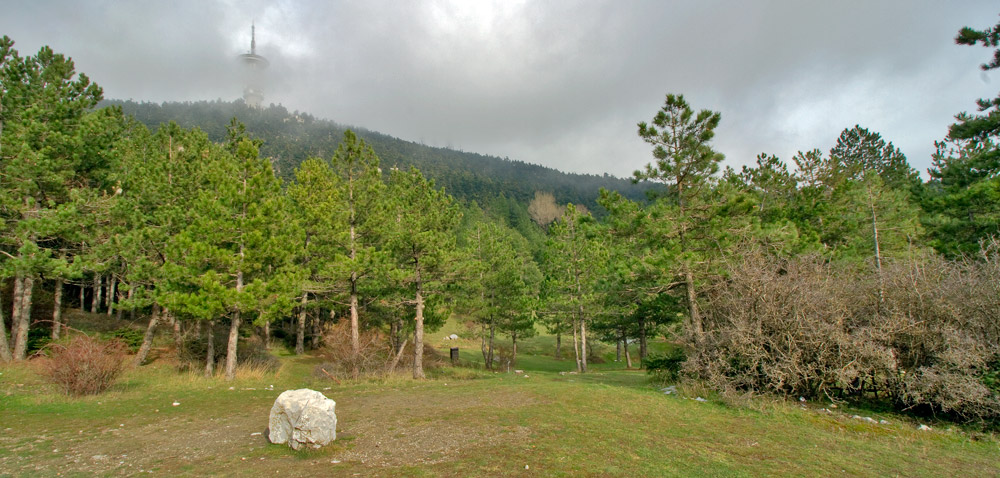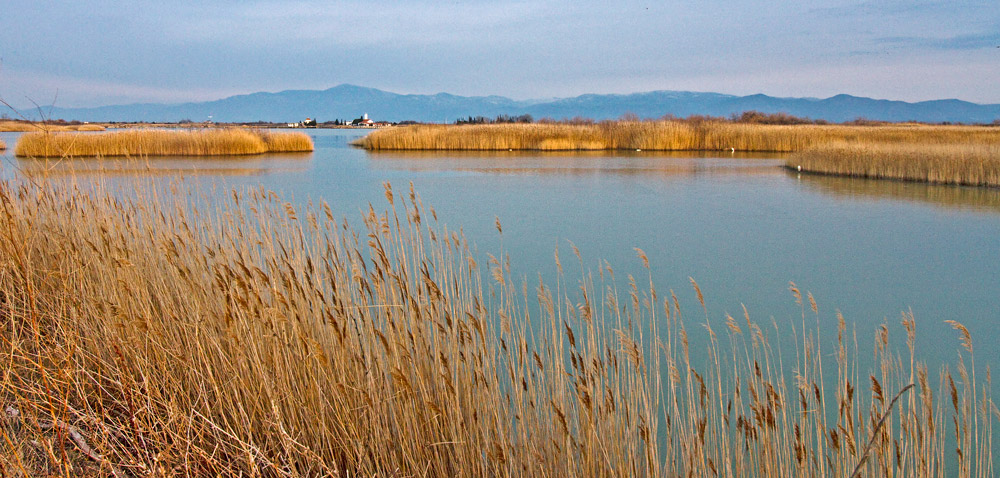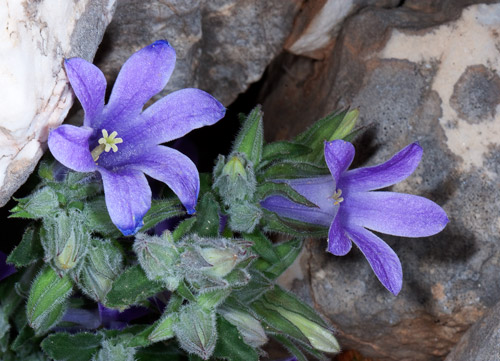National Parks
Parnitha

The long-suffering Parnitha mountain spreads out to the north of Attica, proving that wildlife manages to survive in spite of the criminal mistakes of humans. The name “Parnitha” originates from the pre-Hellenic root “parna” which means “stone, mountain”. The famous mountain is located in the north of Attica and extends up to the border with the prefecture of Boeotia. To the west Parnitha joins with the Kithairon mountain through Pastra, to the north extends up to a few kilometers before the Southern Euboean gulf, to the east looks at the Penteli mountain and the areas around the lake Marathon and to the south crowns the Athens basin and the Thriassion plain. Parnitha stretch out to an area of about 300 sq.kilometres, the length from East to West is 32 km and from North to South 17 km, including many peaks, small gorges, ravines and beautiful plateaus. In the backbone of the mountain there are 16 peaks with an altitude of more than 1,000 meters with the highest being Karavola (1,413 m.) followed by Avgo (1,350 m.), Kakia Rachi (1,261 m.), Kyra (1,160 m.) and Flambouri (1,158 m.). Characteristic of Parnitha are the small mountain plateaus, such as Mola, Xerolivado, Saloniki, Limikos and Gaidourovrysi and the many seasonal streams with the most important being that of Gouras, Agia Triada, Huni, Mola and Mavrorema. There are about 45 water sources, with the most famous being Kithara, which fed the ancient Hadrian aqueduct that carried water to Athens up to the tank of Kolonaki in the centre of the city. At the eastern foothills lies the famous Tatoi Forest which is characterised by an impressive mixed vegetation. The mountain is dominated by limestone rocks with few schists in ravines and valleys. Parnitha is one of the first National Parks created in Greece since 1961. The big fire of 2007 changed dramatically the natural landscape of the mountain. The fire wiped out about 2,600 acres of pine forests, 5,450 acres of fir forests and 1,100 acres of maquis, leaving much of the mountain bare. However, Parnitha still retains a great wealth of rare species of flora and fauna, while the rather easy paths gather thousands of walkers every year.
Parnitha is distinguished by two main vegetation zones. Low altitudes are covered by the typical mediterranean vegetation with forests of aleppo pines, kermes oaks, evergreen oaks, pubescent oaks, maples, poplars, mock privets, Judas trees, greek strawberry trees, common strawberry trees and lentiscs. Above 800 m. starts the forest of greek firs, which, after the fires, are confined mainly to the northeast. The ravines are dominated by plane trees, willows and ashes, while on the eastern slopes there are a few remaining dense oak forests. The flora of Parnitha consists of about 1,100 species from which Campanula celsii subsp. parnesia and Silene oligantha subsp. parnesia are the only endemic species of the mountain. Other important species are Tulipa hageri, Asperula baenitzii, Allium brussalisii, Coriaria myrtifolia, Paeonia mascula subsp. hellenica, Inula verbascifolia subsp. parnassica, Lilium chalcedonicum, Fritillaria graeca, Crocus flavus subsp. atticus, Crocus olivieri, Crocus nivalis, Tulipa australis, Viola hymettia, Vicia pinetorum, Aubrieta deltoidea, Iris attica, Lomelosia hymettia, Satureja parnassica subsp. parnassica, Astragalus hellenicus, Dianthus serratifolius subsp. serratifolius and Myosurus heldreichii. The flora is supplemented by species such as Thymus atticus, Cerastium candidissimum, Allium hymettium, Allium cyrilii, Aethionema saxatile subsp. graecum, Colchicum bivonae, Anemone blanda, Corydalis solida subsp. incisa, Astragalus angustifollius, Silene gigantea subsp. hellenica, Hornungia petraea, Veronica acinifolia, Asyneuma limonifolium, Orobanche baumanniorum, Atropa belladonna, Lamium garganicum subsp. striatum, Scilla bifolia, Vicia melanops and Thlaspi bulbosum. From the orchids stand out Cephalanthera damasonium, Epipactis helleborine, Epipactis microphylla, Himantoglossum jankae, Anacamptis pyramidalis, Orchis anthropophorum, Orchis provincialis, Orchis italica, Orchis quadripunctata, Ophrys attica, Ophrys leochroma, Ophrys leucadica, Ophrys perpusilla, Ophrys apifera and Ophrys iricolor.
About 130 species of birds have been recorded here. In the past golden eagles and griffon vultures lived in Parnitha, while there are reports of foreign travellers from the 19th century for the presence of lammergeiers leaving Parnitha for the slaughterhouses of Piraeus, getting bones to their beaks and returning to the mountain. Today the birds of prey here are short-toed eagles, honey buzzards, common buzzards, sparrowhawks, levant sparrowhawks, peregrines and kestrels. The night predators include eagle owls, tawny owls, little owls and scops owls. Permanent and intense is the presence of coal tits, firecrests and treecreepers in the fir forests. The avifauna is supplemented with species, such as woodcocks, woodpigeons, turtle doves, nightjars, swifts, alpine swifts, hoopoes, crested larks, woodlarks, water pipits, tree pipits, wrens, dunnocks, robins, redstarts, black redstarts, northern wheatears, whinchats, song thrushes, mistle thrushes, fieldfares, ring ouzels, subalpine warblers, goldcrests, spotted flycatchers, pied flycatchers, long-tailed tits, red-backed shrikes, jays, ravens, bramblings, linnets, greenfinches, goldfinches, siskins, serins, hawfinches, crossbills, cirl buntings, rock buntings and Cretzschmar’s buntings.
From the amphibians here live common toads, green toads and tree frogs. Herpetofauna includes 22 species, like marginated tortoises, Hermann’s tortoises, Kotschy’s geckos, balkan green lizards, common wall lizards, Erhard’s wall lizards, ocellated skinks, balkan whip snakes, Dahl’s whip snakes, leopard snakes, grass snakes and nose-horned vipers. Mammals are represented by 37 species, such as foxes, badgers, wild boars, weasels, beech martens, hedgehogs, hares, common moles and cretan wild goats (Capra aegagrus) introduced here in 1961. Pausanias in “Attica” notes that “...in Parnitha one can hunt wild boar and bears”. Naturalist Heldreich states that in 1862 a balkan lynx was killed in Parnitha. The protagonist of the mountain fauna here is the red deer with about 700 animals, all descendants from the north european red deer race -and not from the Balkan race that lived here - brought by the royal family in the 19th century. Most of them create groups that live in remote areas but many have become quite familiar to the human presence. After the big fire of Parnitha, the habitats of the deers vanished and many began to appear in lowland areas around the suburbs of Athens. Unfortunately their presence in the burned areas is a negative factor for the regeneration of the pine forest. In recent years wolfs had made an impressive reappearance on the mountain, which can only be described as a salvation for the biodiversity. Wolves will eventually bring the overpopulation of deers in correct numbers and the burned areas will be able to “breathe” and reborn.
Parnitha is distinguished by two main vegetation zones. Low altitudes are covered by the typical mediterranean vegetation with forests of aleppo pines, kermes oaks, evergreen oaks, pubescent oaks, maples, poplars, mock privets, Judas trees, greek strawberry trees, common strawberry trees and lentiscs. Above 800 m. starts the forest of greek firs, which, after the fires, are confined mainly to the northeast. The ravines are dominated by plane trees, willows and ashes, while on the eastern slopes there are a few remaining dense oak forests. The flora of Parnitha consists of about 1,100 species from which Campanula celsii subsp. parnesia and Silene oligantha subsp. parnesia are the only endemic species of the mountain. Other important species are Tulipa hageri, Asperula baenitzii, Allium brussalisii, Coriaria myrtifolia, Paeonia mascula subsp. hellenica, Inula verbascifolia subsp. parnassica, Lilium chalcedonicum, Fritillaria graeca, Crocus flavus subsp. atticus, Crocus olivieri, Crocus nivalis, Tulipa australis, Viola hymettia, Vicia pinetorum, Aubrieta deltoidea, Iris attica, Lomelosia hymettia, Satureja parnassica subsp. parnassica, Astragalus hellenicus, Dianthus serratifolius subsp. serratifolius and Myosurus heldreichii. The flora is supplemented by species such as Thymus atticus, Cerastium candidissimum, Allium hymettium, Allium cyrilii, Aethionema saxatile subsp. graecum, Colchicum bivonae, Anemone blanda, Corydalis solida subsp. incisa, Astragalus angustifollius, Silene gigantea subsp. hellenica, Hornungia petraea, Veronica acinifolia, Asyneuma limonifolium, Orobanche baumanniorum, Atropa belladonna, Lamium garganicum subsp. striatum, Scilla bifolia, Vicia melanops and Thlaspi bulbosum. From the orchids stand out Cephalanthera damasonium, Epipactis helleborine, Epipactis microphylla, Himantoglossum jankae, Anacamptis pyramidalis, Orchis anthropophorum, Orchis provincialis, Orchis italica, Orchis quadripunctata, Ophrys attica, Ophrys leochroma, Ophrys leucadica, Ophrys perpusilla, Ophrys apifera and Ophrys iricolor.
About 130 species of birds have been recorded here. In the past golden eagles and griffon vultures lived in Parnitha, while there are reports of foreign travellers from the 19th century for the presence of lammergeiers leaving Parnitha for the slaughterhouses of Piraeus, getting bones to their beaks and returning to the mountain. Today the birds of prey here are short-toed eagles, honey buzzards, common buzzards, sparrowhawks, levant sparrowhawks, peregrines and kestrels. The night predators include eagle owls, tawny owls, little owls and scops owls. Permanent and intense is the presence of coal tits, firecrests and treecreepers in the fir forests. The avifauna is supplemented with species, such as woodcocks, woodpigeons, turtle doves, nightjars, swifts, alpine swifts, hoopoes, crested larks, woodlarks, water pipits, tree pipits, wrens, dunnocks, robins, redstarts, black redstarts, northern wheatears, whinchats, song thrushes, mistle thrushes, fieldfares, ring ouzels, subalpine warblers, goldcrests, spotted flycatchers, pied flycatchers, long-tailed tits, red-backed shrikes, jays, ravens, bramblings, linnets, greenfinches, goldfinches, siskins, serins, hawfinches, crossbills, cirl buntings, rock buntings and Cretzschmar’s buntings.
From the amphibians here live common toads, green toads and tree frogs. Herpetofauna includes 22 species, like marginated tortoises, Hermann’s tortoises, Kotschy’s geckos, balkan green lizards, common wall lizards, Erhard’s wall lizards, ocellated skinks, balkan whip snakes, Dahl’s whip snakes, leopard snakes, grass snakes and nose-horned vipers. Mammals are represented by 37 species, such as foxes, badgers, wild boars, weasels, beech martens, hedgehogs, hares, common moles and cretan wild goats (Capra aegagrus) introduced here in 1961. Pausanias in “Attica” notes that “...in Parnitha one can hunt wild boar and bears”. Naturalist Heldreich states that in 1862 a balkan lynx was killed in Parnitha. The protagonist of the mountain fauna here is the red deer with about 700 animals, all descendants from the north european red deer race -and not from the Balkan race that lived here - brought by the royal family in the 19th century. Most of them create groups that live in remote areas but many have become quite familiar to the human presence. After the big fire of Parnitha, the habitats of the deers vanished and many began to appear in lowland areas around the suburbs of Athens. Unfortunately their presence in the burned areas is a negative factor for the regeneration of the pine forest. In recent years wolfs had made an impressive reappearance on the mountain, which can only be described as a salvation for the biodiversity. Wolves will eventually bring the overpopulation of deers in correct numbers and the burned areas will be able to “breathe” and reborn.
Πως θα πάτε
Parnitha is very close to Athens. From the Athens-Lamia National Road there are exits in both traffic streams. From there you need about 20 minutes to reach the cablecar at the foot of the mountain. Then you can continue by car until you reach the mountain plateaus (30 minutes) or take the cablecar and continue your walk.Εμφάνιση στο χάρτη
click to see the place on the map(Latitude: 38.15838575420022, Longitude:23.717069429379194)
Social Networks
Also Read

Nestos Delta and lakes Vistonida-Ismarida
One of the most important wetland complex of the Balkans that spreads on the coast of the Thracian sea and magnetizes thousands of birds every year.

Prespa lakes
Two beautiful lakes crowned by large mountain ranges that unite three nations, creating what is considered to be one of Europe’s most important habitats.













